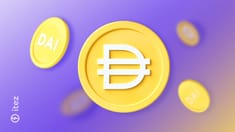Dai FAQ
What is Dai (DAI), and how does it differ from other cryptocurrencies?
Dai (DAI) is a stablecoin operating on the Ethereum blockchain and maintaining a 1:1 peg with the US dollar.
How does Dai achieve its price stability?
DAI maintains stability using a system of smart contracts and collateral.
What's the significance of Dai's decentralized nature?
Dai offers financial autonomy to its holders as it's governed by users and operates without a centralized authority.
How can I obtain Dai?
You can buy or stake Dai through such crypto exchanges as Binance, Coinbase, Kraken, and OKX. Also you can buy Dai via licensed itez service, where you can smoothly pay for crypto with a bank card or SEPA. Moreover, you may also get Dai through the MakerDAO system.
Is Dai subject to price fluctuations like other cryptocurrencies?
Compared to many other cryptocurrencies, Dai is relatively stable, as it is a stablecoin pegged to the US dollar rate. However, it still can experience fluctuations as the market is dynamic.
What role does the MakerDAO system play in the Dai ecosystem?
MakerDAO is the decentralised organisation. It's the issuer of two coins: Dai (DAI) and Maker (MKR). Dai is used as a stablecoin, while MKR is MakerDAO's governance token. The organisation makes desicions on the project's development through a desentralised voting process, where every MKR holder has a say.
Can Dai be used for everyday transactions?
Yes, just like any other stablecoin. Dai's price is stable, so users can easily make everyday purchases using it.
What's the risk of Dai's collateral becoming undercollateralized?
The MakerDAO system has safeguards to prevent undercollateralisation. But it's still essential to monitor its health.
Can Dai be used for cross-border payments?
Yes, Dai is stable and also easy to use. So, it can be a very practical and good choice to use the asset for cross-border payments.
How does Dai contribute to the DeFi ecosystem?
Having a stable price, Dai provides the DeFi ecosystem with a firm store of value. It helps avoid volatile market conditions.
What's the significance of Dai's audits and transparency?
Dai's audits and transparency are the most important factors to build trust among the crypto community. Audits verify whether its smart contracts are secure, which ensures the stablecoin's peg stability.
Transparency, in its turn, fosters credibility and attracts new users.
Can I use Dai to access loans in the DeFi space?
Yes, as Dai is utilised as collateral to secure loans on different DeFi platforms. Users can lock their stablecoins in smart contracts and borrow other assets.
Is Dai regulated like traditional fiat currencies?
Dai is a decentralised stablecoin, so it's not regulated like traditional fiat currencies.
What are the advantages of using Dai over other stablecoins?
Some of the main Dai advantages are decentralisation, stability mechanism maintained through decentralised systems of smart contracts, collateral flexibility, transparency, and community governance.
How does Dai handle scalability issues on the Ethereum network?
As a stablecoin on the Ethereum network, Dai doesn't directly address scalability issues. But it surely benefits from layer 2 scaling solutions built on top of the mainnet. Dai can also leverage sidechains connected to Ethereum to offload some transaction volume and optimise its smart contracts to reduce gas costs in the blockchain.
Can Dai be used in yield farming and liquidity provision?
Yes, Dai is commonly used in yield farming and liquidity provision. As for yield farming, users can deposit Dai into liquidity pools on DEXs or lending protocols and earn rewards in return. Liquidity provision means that users contribute Dai and another asset to liquidity pools and enable decentralised trading between these two assets.
Is Dai's supply capped?
Dai's supply is not capped but dynamically adjusted based on market demand and supply through its decentralised stability mechanism.
How can I track the price of Dai?
Users can track Dai's price on exchanges where the asset is traded. Moreover, they can also use such platforms as CoinGecko or CoinMarketCap.
What's the long-term outlook for Dai?
Dai's long-term outlook depends on a number of factors, including its stability mechanism, adoption in DeFi, competition, and regulatory landscape.
Articles
 Meet BNT, CRV, MC, and XCAD on itez widget
Meet BNT, CRV, MC, and XCAD on itez widget
This fall, we've launched a new SWAP feature, so more coins are coming soon!
 What is DAI: world's first fair currency ultimate review
What is DAI: world's first fair currency ultimate review
Let's learn more about MakerDAO, how it works, and the role of DAI stablecoin in its ecosystem.


